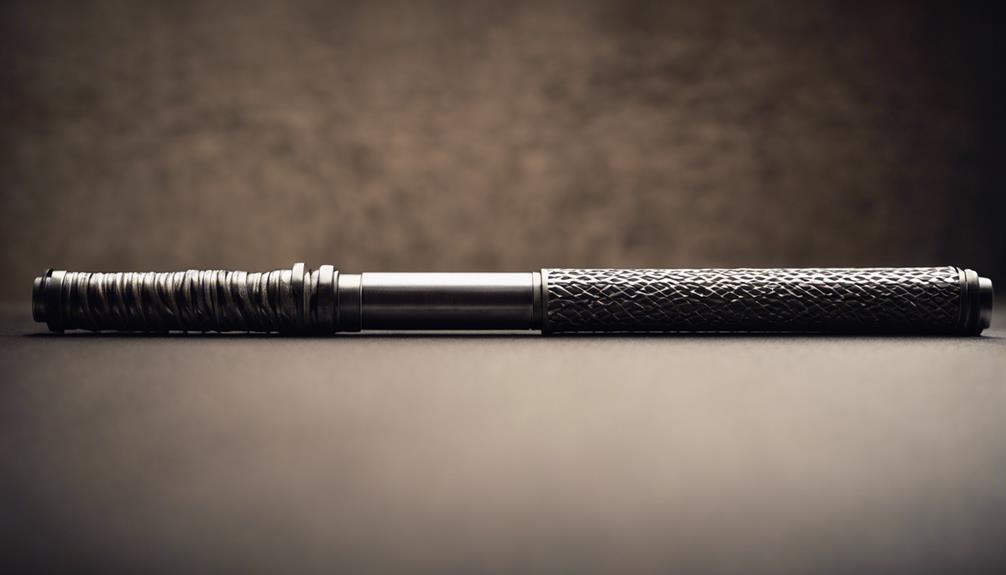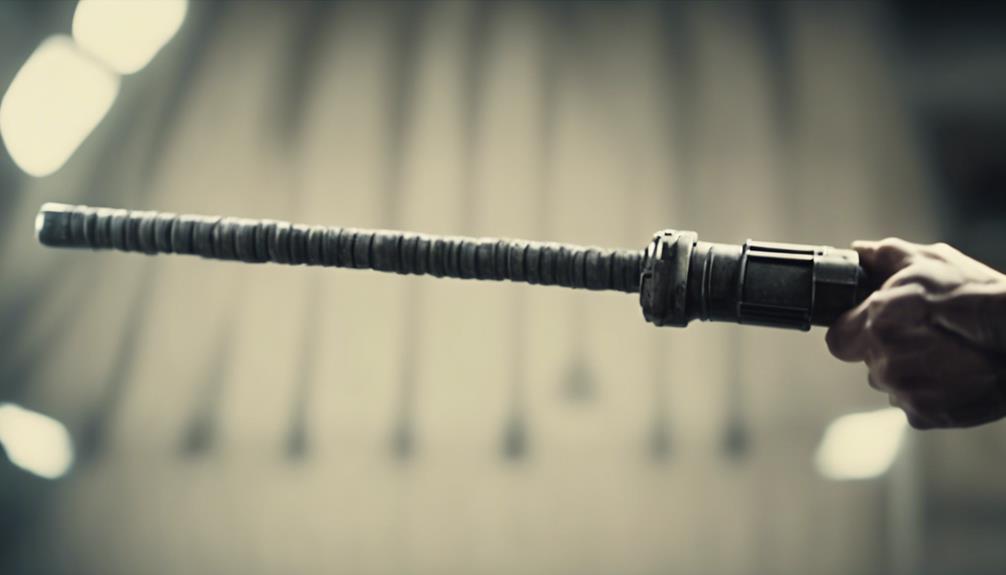Imagine you’re in a
self-defense scenario where you wield a
telescopic baton, aiming for an assailant’s arm. The strike lands with a resounding crack, leading you to wonder: did you just shatter a bone? Understanding whether a baton can indeed
fracture bones involves examining its design, the force exerted, and your
striking technique. By exploring the nuances of kinetic energy and proper training, you’ll uncover how to maximize a baton’s effectiveness while maintaining safety. So, can a telescopic baton truly shatter bones, or is it merely a myth? Let’s sort out the facts from the fiction.
Historical Evolution of Batons
The
historical evolution of batons showcases humanity’s ongoing quest for
effective law enforcement tools. Imagine yourself in
ancient times, where batons started as simple, straight sticks. These rudimentary tools were the backbone of
crowd control and law enforcement. Picture guards and officers wielding these wooden batons to maintain order.
Fast forward a few centuries, and you’d notice batons transforming. No longer just basic sticks, they became more sophisticated, adapting to the needs of the time. The shift from traditional straight batons to
modern variations like
expandable batons marked a significant leap. You can now imagine the convenience and portability these new designs offer. No more lugging around heavy, unwieldy batons; instead, you’ve got sleek, compact tools that snap open with ease.
Technological advancements played a huge role too. Think of the
Monadnock Auto Lock, a
game-changer in baton locking mechanisms. This innovation guarantees your baton stays secure and reliable when you need it most. Manufacturers didn’t stop there. They constantly refined batons, focusing on weight distribution and ease of use to make certain you have the best tool at hand. The evolution of batons mirrors the broader trend of enhancing
safety and efficiency in law enforcement tools.
Modern Innovations in Batons
Modern batons have seen
impressive advancements, continuing the evolution from their ancient counterparts. The modern innovations in baton design are nothing short of remarkable. Take the
Monadnock Auto Lock, for instance—it features an
advanced locking mechanism that drastically enhances security and reliability during use. You won’t have to worry about it collapsing at the worst possible moment.
Expandable batons are another contemporary marvel. These bad boys can be compactly stored without losing any portability. Imagine carrying a full-sized baton that’s as small as a flashlight when not in use. How cool is that? The
telescopic steel baton with rubber handle is a prime example of modern design, offering lengths of 16, 21, and 26 inches, yet closing to a mere 6.5 inches for easy storage.
Manufacturers are continuously improving materials and designs, focusing on weight distribution to give you maximum effectiveness while keeping user fatigue to a minimum. It’s like they’ve thought of everything!
Ergonomic grips and
improved friction locks have been incorporated into the latest models, making handling and control a breeze.
These innovations aim to tackle the
performance limitations of older models, ensuring
modern batons are more effective in various
law enforcement scenarios. From better grip to more secure locking, today’s batons are designed to be
reliable partners, whether you’re on the beat or in a tricky situation.
Factors Influencing Baton Effectiveness
When it comes to
baton effectiveness, several key factors come into play that you can’t afford to overlook. First, the
physical characteristics of your impact weapon matter a lot. Things like the length, circumference, and density all contribute to how much force your baton delivers. A longer, denser baton can pack a bigger punch. Additionally, the locking mechanism guarantees that the baton remains secure during use, enhancing its reliability and impact force.
Next, your own
skills and confidence really make a difference.
Proper training helps you strike with more power, speed, and accuracy. Imagine hitting a target squarely because you know exactly how to swing. It’s not just about brute strength but also about technique and timing.
Different types of batons, like straight stick batons or expandable ones, also affect the impact. Heavier, straight batons usually deliver harder blows. Think of it like comparing a sledgehammer to a regular hammer.
Mass and Acceleration Impact
When you’re swinging a telescopic baton, you need to think about both its weight and how fast you’re moving it. The harder and quicker you strike, the more
kinetic energy you transfer, making your strike much more
powerful. Imagine the impressive force you can generate with the right combo of mass and speed, enough to make a real impact when you need it most.
Kinetic Energy Transfer
Harnessing the full potential of a telescopic baton hinges on understanding the principles of
kinetic energy transfer, specifically the impacts of
mass and acceleration. When you
swing that baton, you’re not just waving a stick around—you’re channeling kinetic energy. This energy is calculated as 1/2 the mass multiplied by the velocity squared (KE = 1/2 mv²), so both the weight of the baton and how fast you swing it matter a lot.
Imagine
swinging a heavy baton with
proper technique, accelerating it swiftly through the air. The heavier the baton, the more kinetic energy it can generate upon impact. This isn’t some lightweight toy; it’s a serious tool. With the right training, you can make that baton feel like an
unstoppable force. Proper technique guarantees you’re maximizing both the mass and acceleration of your strike, optimizing kinetic energy transfer to achieve the desired effect.
Focus your strike, and you’re
concentrating that kinetic energy on a smaller area, increasing the likelihood of causing severe injury, even shattering bones. It’s all about
precision and power—understanding these principles lets you wield the baton effectively and safely.
Strike Force Dynamics
Understanding the
strike force dynamics of a telescopic baton requires delving into the effects of
mass and acceleration. When you swing a baton, its effectiveness hinges on how heavy it is and how fast you can get it moving. The
heavier the baton and the quicker your swing, the more
kinetic energy you’ll release on impact. Telescopic batons, while nifty and compact, sometimes don’t pack the same punch as their beefier, straight stick cousins. This difference in mass can affect how much force you generate, which is essential if you’re aiming to shatter bones. But don’t fret!
Proper technique can make a world of difference. By mastering body mechanics and timing, you can boost the kinetic energy delivered in each strike.
The baton’s
density and circumference also play a part. A denser, wider baton can distribute force more effectively, upping the chances of causing serious injury.
Training is key here. You need to develop speed, power, and accuracy to wield your baton like a pro, especially in high-stress situations. For those looking to combine
self-defense tools, consider adding a flashlight to your arsenal, which can disorient attackers and provide practical illumination.
Importance of Proper Training
Mastering the use of a
telescopic baton requires more than just owning the tool; it demands
proper training to develop essential skills like power, speed, timing, and accuracy. You can’t just swing it around and hope for the best. Knowing how to strike effectively is key, and that’s where proper training comes in. Unlike other self-defense tools, the telescopic baton offers extra reach for increased safety, making it a valuable asset when used correctly.
In training sessions, you’ll focus on
striking techniques,
control holds, and shifts. These aren’t just fancy terms; they’re vital for ensuring you use the baton safely and effectively during encounters. Understanding the principles of
kinetic energy, mass, and acceleration will help you maximize your strike impact. It’s like science class but way more intense and practical.
Situational awareness is another biggie. During confrontations, you need to
adapt your techniques based on
changing distances and target focus. It’s a bit like playing a real-life video game, where you have to stay sharp and ready for anything.
Continuous training isn’t just about
muscle memory; it builds
confidence in your ability to deploy the baton effectively. This confidence minimizes the risk of injury to both you and the subject. So, stick with it and keep practicing – it’s your best bet for staying safe and effective out there.
Types of Law Enforcement Batons
Law enforcement officers rely on two primary types of batons:
straight stick batons and
expandable batons. Straight stick batons are the old-school,
solid tools of the trade. They’re heavier and pack a punch, giving you that satisfying thud when you need it. They’re great for making a statement but carrying them around can be a bit of a hassle due to their size.
Now, let’s talk about the sleek, modern alternative: expandable batons. These bad boys are all about
convenience. Compact when holstered, they extend with a swift flick of the wrist, making them perfect for
quick deployment. Models like the Monadnock Auto Lock even come with
advanced locking mechanisms, adding an extra layer of safety and reliability.
Sure, they might not have the same mass as their straight stick counterparts, but they make up for it in ease of carrying. You can discreetly tuck them away and whip them out only when needed.
Features of Expandable Batons
Expandable batons are super handy because they shrink down to a
pocket-sized 6-9 inches but snap out to a mighty 21-26 inches when you need them. You’ll love the sturdy feel of aluminum or steel, and advanced
locking mechanisms like the Monadnock Auto Lock keep it from folding up when you’re in action. These batons, such as the Automatic Expandable Steel Baton, pack a punch with the
perfect balance of weight and length, making certain you can strike effectively, even in tight spots. Furthermore, the option to choose different lengths guarantees that you have the right tool for
various situations.
Compact Carrying Convenience
In addition to their effectiveness, the compact carrying convenience of expandable batons makes them invaluable tools for both law enforcement and personal defense. You’ll love how easily an expandable baton can slip into your belt holster or pocket. Imagine walking down the street, knowing you’ve got a powerful tool right there, ready to extend in a flash. It’s like having a secret weapon that fits right into your daily routine without a hitch.
Expandable batons typically range from 15 to 26 inches when extended, giving you that vital extra distance in a sticky situation. When collapsed, they’re small enough to carry comfortably without feeling bulky or noticeable. This compact design means you’ve got the convenience of quick accessibility, which can make all the difference in an emergency.
Here’s a quick look at why you’ll find expandable batons so handy:
| Feature |
Benefit |
| Collapsible Design |
Easy to carry and conceal |
| Extended Length |
Provides essential standoff distance |
| Belt Holster Fit |
Enhances accessibility and readiness |
| Lightweight |
Comfortable for all-day carry |
Enhanced Locking Mechanisms
When you’re relying on an
expandable baton, the last thing you want is for it to collapse unexpectedly. That’s where
enhanced locking mechanisms come into play. Imagine you’re in a
high-stress situation, and your baton suddenly
retracts—talk about a nightmare! Luckily, modern batons, like the
Monadnock Auto Lock, are designed to prevent that. These enhanced locking mechanisms guarantee your baton stays extended, even under intense pressure.
Now, let’s talk about
friction locks. These nifty designs let you
deploy and retract your baton quickly, which is a lifesaver when seconds count. Plus, they distribute the baton’s mass more evenly, giving you better control and a more powerful strike. It’s like having the perfect dance partner—always in sync and ready to move.
Manufacturers are always tweaking and improving these locking systems, focusing on making them
more durable and safer. So, each new model usually outshines the last. It’s like upgrading your smartphone—just when you thought it couldn’t get any better, it does.
In short, enhanced locking mechanisms aren’t just a fancy add-on; they’re crucial for your safety and effectiveness. Your baton isn’t just a tool; it’s a trusted ally.
Mass and Impact Dynamics
While
enhanced locking mechanisms keep your baton reliably extended, understanding
mass and impact dynamics is equally essential. You see,
expandable batons generally have a smaller mass compared to traditional straight stick batons. This
lighter weight can limit their ability to deliver those bone-shattering strikes. But don’t let that discourage you! The real magic lies in how you wield it.
Your skill in generating
kinetic energy through
proper striking techniques makes all the difference. Think of it like swinging a baseball bat—anyone can swing, but it takes practice to hit a home run. The
compact design of expandable batons makes them super easy to carry around, but it might compromise mass distribution during impact. That’s where your training comes in.
Locking mechanisms like the Monadnock Auto Lock add stability, sure, but they still rely heavily on your technique. Training in timing, power, and accuracy is key to maximizing the impact potential. Picture yourself landing a
perfect strike—sharp, precise, and powerful. That’s when you’ll see what an expandable baton can really do, even against hard targets like bones.
Pros and Cons of Different Batons
Choosing the right baton can make a significant difference in law enforcement effectiveness, and understanding the pros and cons of different types is essential. When you’re selecting a police baton, you’ve got a few options, each with its own set of benefits and drawbacks.
- Straight Stick Batons: These batons pack a punch due to their mass, making them great for delivering powerful strikes. However, they can be bulky, and carrying them around isn’t the easiest task.
- Expandable Batons: These are the go-to for portability. They’re compact and easy to carry, but they do lose out on impact force because they’re lighter. It’s a trade-off between convenience and power.
- Friction Lock Batons: These batons secure themselves when extended, offering a reliable, sturdy option during confrontations. Yet, they can sometimes be tricky to retract, especially in high-stress situations.
- Locking Mechanisms like Monadnock Auto Lock: These provide extra security and ease of use. They guarantee your baton stays locked when you need it but can be a bit pricier than other options.
Understanding these pros and cons helps you choose the right tool for the job, balancing effectiveness with practicality.
Techniques for Effective Baton Use
Mastering
effective baton use isn’t just about brute strength; it’s about
precision and technique. You need to understand where to strike, like targeting
vulnerable joints, to maximize impact with minimal force.
Law enforcement officials often train extensively in these techniques for effective baton use, ensuring they can incapacitate an assailant without going overboard. It’s not just swinging wildly; it’s about hitting the right spots.
Physics plays a big role here. Knowing that
mass and acceleration boost your strike’s power means you can deliver a blow that really counts. But don’t just stop at striking – shifts between strikes and
control holds are vital. This adaptability can be a game-changer in dynamic and tense situations.
Then there’s the baton itself. Familiarizing yourself with its
locking mechanism, like the Monadnock Auto Lock, is essential. You want that baton to stay extended when you need it most, avoiding any embarrassing retractions mid-action.
Lastly, don’t forget
de-escalation. Incorporating these techniques into your training helps in resolving confrontations without always resorting to
physical force. It’s about keeping control, staying safe, and doing your job effectively. It’s a dance, really, and you’ve got to know the steps.
Tactical Considerations in Baton Deployment
When you’re thinking about deploying a
telescopic baton, you need to evaluate the perfect mix of distance and timing. Getting too close can make you vulnerable, while staying too far might render your strikes ineffective. And let’s not forget, the
energy transfer from your baton to the target relies heavily on how fast you swing and the baton’s weight, so
proper technique is essential to make every strike count.
Distance and Timing
In the domain of tactical baton deployment, maintaining the appropriate distance is crucial for effective strikes and minimizing the risk of counterattacks. You’ve got to keep that perfect gap between you and the assailant, giving you the upper hand. Timing, on the other hand, is your secret weapon—strike when the moment’s right, and you pack a punch that’s hard to ignore.
Imagine this scenario: you’re facing an attacker, and you need to act fast. Here’s what you need to take into account:
- Distance: Keep just enough space to swing your baton effectively without letting the attacker get too close.
- Timing: Assess the situation quickly. The best strikes come when you catch the assailant off-guard.
- Adaptability: Be ready to adjust your stance and distance as the encounter evolves. A good officer knows how to flow with the fight.
- Transitions: Moving between strikes and holds seamlessly can make a world of difference. Precision in timing guarantees you stay in control.
Energy Transfer Techniques
Building on the importance of distance and timing, let’s shift focus to
energy transfer techniques in
baton deployment. When swinging that telescopic baton, it’s all about channeling mass and acceleration into a single,
powerful strike. You want to hit your target with the right amount of force, making each swing count. The key here is maintaining the
perfect distance. Too close, and you lose momentum; too far, and you risk a weak strike or missing altogether.
Timing is everything. You’ve got to strike when it matters most, ensuring
maximum kinetic energy transfer. This means waiting for that perfect moment when your opponent is most vulnerable. Speaking of vulnerability, always aim for those
critical spots. A well-placed hit to a joint or muscle group can incapacitate someone much faster than a random swing.
Adaptability is your friend. In the heat of the moment, you might need to switch from striking to
control holds. This flexibility helps you manage energy transfer effectively, keeping you in control of the situation. Remember, it’s not just about brute force; it’s about smart,
calculated moves that make every hit count. Keep practicing those energy transfer techniques, and you’ll handle that baton like a pro!
Frequently Asked Questions
Can Telescopic Batons Break Bones?
Yes, telescopic batons can cause a bone fracture if used with sufficient force and proper technique. It’s essential to understand that while they’re designed for less lethal force, improper use could lead to serious injuries, including fractures.
Do Telescopic Batons Work?
Telescopic batons work effectively as a self-defense tool when used correctly. They provide a compact, rapidly deployable option for personal protection. With proper training, you can maximize their potential for effective striking and control in confrontations.
Batons are effective self-defense tools when used correctly. Your skill, technique, and the type of baton greatly influence their impact. Proper training guarantees you can deliver powerful strikes, making them a reliable option for incapacitating threats.
How Much Damage Can a Baton Do?
You’ll find that a baton can cause substantial damage, including fractures, especially when aimed at vulnerable areas. With proper striking technique and targeting, the injury risks increase considerably, making it a powerful tool in trained hands.









